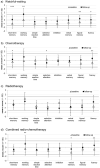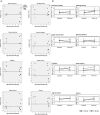Long-term neurocognitive function and quality of life after multimodal therapy in adult glioma patients: a prospective long-term follow-up
- PMID: 37648934
- PMCID: PMC10522752
- DOI: 10.1007/s11060-023-04419-y
Long-term neurocognitive function and quality of life after multimodal therapy in adult glioma patients: a prospective long-term follow-up
Abstract
Purpose: Multimodal therapies have significantly improved prognosis in glioma. However, in particular radiotherapy may induce long-term neurotoxicity compromising patients' neurocognition and quality of life. The present prospective multicenter study aimed to evaluate associations of multimodal treatment with neurocognition with a particular focus on hippocampal irradiation.
Methods: Seventy-one glioma patients (WHO grade 1-4) were serially evaluated with neurocognitive testing and quality of life questionnaires. Prior to (baseline) and following further treatment (median 7.1 years [range 4.6-11.0] after baseline) a standardized computerized neurocognitive test battery (NeuroCog FX) was applied to gauge psychomotor speed and inhibition, verbal short-term memory, working memory, verbal and non-verbal memory as well as verbal fluency. Mean ipsilateral hippocampal radiation dose was determined in a subgroup of 27 patients who received radiotherapy according to radiotherapy plans to evaluate its association with neurocognition.
Results: Between baseline and follow-up mean performance in none of the cognitive domains significantly declined in any treatment modality (radiotherapy, chemotherapy, combined radio-chemotherapy, watchful-waiting), except for selective attention in patients receiving chemotherapy alone. Apart from one subtest (inhibition), mean ipsilateral hippocampal radiation dose > 50 Gy (Dmean) as compared to < 10 Gy showed no associations with long-term cognitive functioning. However, patients with Dmean < 10 Gy showed stable or improved performance in all cognitive domains, while patients with > 50 Gy numerically deteriorated in 4/8 domains.
Conclusions: Multimodal glioma therapy seems to affect neurocognition less than generally assumed. Even patients with unilateral hippocampal irradiation with > 50 Gy showed no profound cognitive decline in this series.
Keywords: Glioma; Multimodal tumor-directed treatment; Neurocognition; Quality of life; Radiotherapy.
© 2023. The Author(s).
Conflict of interest statement
Michael Sabel has served as Consultant for Novocure, Integra /Codman; Klaus Fliessbach and Christian Hoppe received license fees from Eisai Inc. (Frankfurt/Main, Germany); Uwe Schlegel received speaker’s honoraria from medac, Novartis, GSK and med update.
Figures



Similar articles
-
Cognitive and radiological effects of radiotherapy in patients with low-grade glioma: long-term follow-up.Lancet Neurol. 2009 Sep;8(9):810-8. doi: 10.1016/S1474-4422(09)70204-2. Epub 2009 Aug 7. Lancet Neurol. 2009. PMID: 19665931
-
A prospective study on neurocognitive effects after primary radiotherapy in high-grade glioma patients.Int J Clin Oncol. 2016 Aug;21(4):642-650. doi: 10.1007/s10147-015-0941-1. Epub 2015 Dec 22. Int J Clin Oncol. 2016. PMID: 26694815
-
Hippocampal radiotherapy dose constraints for predicting long-term neurocognitive outcomes: mature data from a prospective trial in young patients with brain tumors.Neuro Oncol. 2020 Nov 26;22(11):1677-1685. doi: 10.1093/neuonc/noaa076. Neuro Oncol. 2020. PMID: 32227185 Free PMC article. Clinical Trial.
-
Current and future strategies in radiotherapy of childhood low-grade glioma of the brain. Part I: Treatment modalities of radiation therapy.Strahlenther Onkol. 2003 Aug;179(8):509-20. doi: 10.1007/s00066-003-9104-9. Strahlenther Onkol. 2003. PMID: 14509949 Review.
-
[Role of radiotherapy in recurrent gliomas].Bull Cancer. 2004 Nov;91(11):883-9. Bull Cancer. 2004. PMID: 15582893 Review. French.
Cited by
-
Vorasidenib: a new hope or a false promise for patients with low-grade glioma?Nat Rev Clin Oncol. 2024 Dec;21(12):835-836. doi: 10.1038/s41571-024-00944-5. Nat Rev Clin Oncol. 2024. PMID: 39266767 No abstract available.
-
The effect of radiation dose to the brain on early self-reported cognitive function in brain and head-and-neck cancer patients.Clin Transl Radiat Oncol. 2025 Feb 8;52:100929. doi: 10.1016/j.ctro.2025.100929. eCollection 2025 May. Clin Transl Radiat Oncol. 2025. PMID: 40028425 Free PMC article.
-
[Vorasidenib for low-grade gliomas-new treatment option with unanswered questions regarding long-term outcomes].Strahlenther Onkol. 2024 Feb;200(2):178-180. doi: 10.1007/s00066-023-02179-2. Epub 2023 Nov 20. Strahlenther Onkol. 2024. PMID: 37982841 Free PMC article. German. No abstract available.
-
The role of vorasidenib in the treatment of isocitrate dehydrogenase-mutant glioma.Neuro Oncol. 2025 Jun 21;27(5):1135-1148. doi: 10.1093/neuonc/noae259. Neuro Oncol. 2025. PMID: 39723472 Review.
-
High costs, low quality of life, reduced survival, and room for improving treatment: an analysis of burden and unmet needs in glioma.Front Oncol. 2024 Mar 20;14:1368606. doi: 10.3389/fonc.2024.1368606. eCollection 2024. Front Oncol. 2024. PMID: 38571509 Free PMC article. Review.
References
-
- Armstrong TS, Wefel JS, Wang M, et al. Net clinical benefit analysis of radiation therapy oncology group 0525: a phase III trial comparing conventional adjuvant temozolomide with dose-intensive temozolomide in patients with newly diagnosed glioblastoma. JCO. 2013;31(32):4076–4084. doi: 10.1200/JCO.2013.49.6067. - DOI - PMC - PubMed
Publication types
MeSH terms
Grants and funding
LinkOut - more resources
Full Text Sources
Medical

